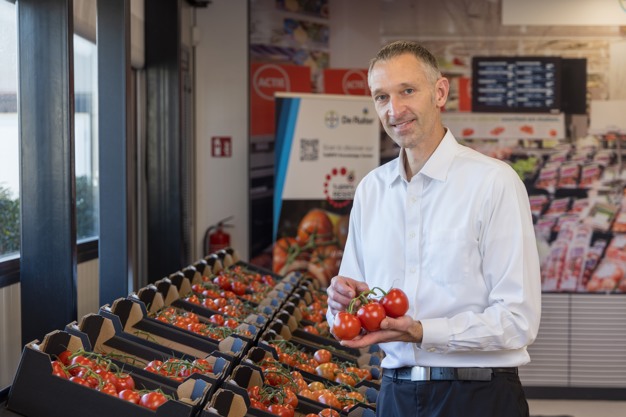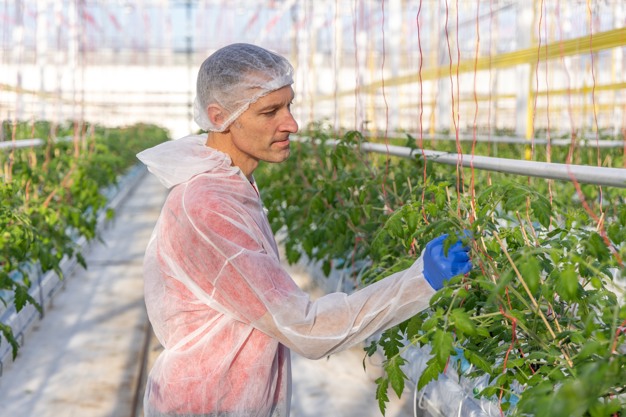Breeding new vegetable varieties can sometimes feel like a juggling act. Seed companies need to take into account not just their own interests, but also have a keen eye for those of growers and consumers. Ethan Luth, Vice President and Head of Vegetable Seeds Commercial Operations EMEA & APAC at Bayer, knows all about that juggling act. With 18 years of experience at Bayer and a strong background in agriculture, the Illinois-born executive now finds himself in the Netherlands, looking after a portfolio of twenty crops– including vegetables grown in a protected environment.

Bringing vegetables to all parts of the world
Ethan has been in the Netherlands for 1.5 years now, so he's seen both the similarities and differences between Europe and his native North America. "Dutch growers are world-leaders in the horticulture industry," Ethan notes. "It's fascinating to see how what's happening here, influences the whole world. Dutch growers can be proud of their pioneering work in the glasshouse industry."
One example of that influence is in the Canadian market. "In the Leamington area, there's a strong connection with Dutch growers. I actually invite a lot of Canadian growers to come take a look at new varieties here. So being here provides a great opportunity to connect with growers everywhere. After all, we help bring vegetables to all parts of the world."
The ToBRFV challenge: it's not over yet
Of course there are challenges along the way – Ethan defines the number one challenge: the need for continued innovation, paired with sustainability. "Growers are facing more challenges with energy, water and disease pressure. We help growers deal with those challenges."
Right now for instance, the team is busy with the rugose virus, known as ToBRFV. "As an industry, we still have a lot of work to do there – viral pathogens tend to change behavior, so we need to keep an eye on that, in case the virus starts to mutate. One way we do that is by working with multiple resistance genes instead of just one. We need to come together with Bayer and growers, and actually across the industry: we will all benefit from bringing better, durable solutions," Ethan argues.
"So we're helping growers not just by bringing disease resistance, but also taking into account agronomics. After all, growers need good production and fruit quality as well. And we have to balance that with the interests of the consumer, who is looking for eating quality, shelf life, taste and nutrition."
Getting vegetables on plates
Zooming in on the consumer, Ethan sees a worrying trend that he's hoping to help reverse: "When we look at consumption, on average we consume 156 grams of vegetables a day, while the recommendation is 250 grams. It's not always easy to get access to those vegetables, so we're trying to help the consumer with that."
One way of doing that is through more snackable vegetables that are easier to consume. Of course, they need to be tasty as well, which is why Bayer has a team that does taste panels. "We ask volunteers what they think of different vegetable samples, to see what they like and what they don't. And we participate in events like De Week van Ons Eten (formerly the Dutch Food Week)."
Bayer is also looking at packing vegetables with more nutrients. "One day we may be able to enhance levels of certain vitamins, like vitamin D." Ethan gives a practical example of Bayer's efforts in this direction: "We've entered into an agreement with South Korean biotech company G+FLAS to collaborate on developing genome-edited tomato varieties that are nutritionally enhanced with vitamin D3. Vitamin D deficiency is a widespread issue globally, particularly in countries where winter sunlight is limited. It affects an estimated billion people worldwide and can lead to a range of health issues including rickets." The ultimate goal for Bayer with projects like this one would be to get people to eat healthier, and at the same time increasing profitability for the grower by encouraging vegetable consumption.
Supporting the grower with data
That brings us to the other main stakeholder in the breeding process: the grower. Bayer collects as much feedback as possible and feeds that back into their R&D organization, Ethan explains. "That way we know how to evaluate, for instance, lines that are more water-efficient or heat-tolerant, which is important in light of the radical temperature changes we're seeing. That way we can develop a germplasm that's more resistant."
Data is key in that process. "We gather a large pool of data, which means we can look at things we wouldn't see through traditional breeding methods. In future, I expect we'll be able to monitor even more: root weight mass, nutrients, microclimates – we'll ingest all that data and make something out of that."

Different regions, different varieties
One challenge that Bayer is hoping to tackle with data, is to keep quality consistent when products from other regions are shipped in during the off-season. "Morocco is a key focus there, they have a lot of produce available during the lower season here. Spain also serves a key part of the counter-season. We can't just take the same variety and grow it there as well, due to differences in climate and water consumption. That's why we're looking for partnerships with entities that grow crops in the Netherlands but that are also diversifying into other geographies."
In addition to the differences in growing circumstances, supply chain timing is another factor to take into account. "Fruit has to be transported longer, with a different quality of shipment and fruit firmness. So we need to look at breeding differently, taking into account heat stress and transportability, but also taste variability. It's not easy, but we can benefit from big data and potentially AI, for example climate algorithms: if a variety works well in certain conditions, it could also do well in similar circumstances in the opposite part of the world."
Current trends and future plans
The breeding team at Bayer also keeps an eye on the bigger trends in the market. "One thing we've noticed is that strawberries are growing as a consumer market, so we made a strategic decision to get into that segment. They're not the easiest crop to grow, but we're working with our other departments at Bayer on biological protection to manage disease challenges – and we're working on new strawberry varieties."
Looking beyond soft fruit at more general developments, Ethan is hoping to shorten the R&D cycle as much as possible. "Let's say we can incorporate more data into early product launches, to give growers more insight to manage and steer the crop – can we take a year off of the introduction process that way? We're a big company, but want to act like a small company with large innovation, by reacting quickly to customer needs and delivering solutions as fast as local companies often do: we want to give growers the tools they need as quickly as possible."
Finally, Ethan draws a five-year horizon: "We're going to continue to evaluate grower and consumer needs, helping the grower produce a crop more easily and getting it into the hands of the consumer for repeat purchasing. To achieve that, we'll have to increase our dialog with the consumer. Traditionally, seed companies work a lot with growers, but we can all benefit from better communication with the consumer. Knowing what the consumer wants, will also benefit both the grower and us as a seed company."
For more information:
Bayer CropScience Vegetable Seeds
Ethan Luth
[email protected]
https://www.vegetables.bayer.com/
